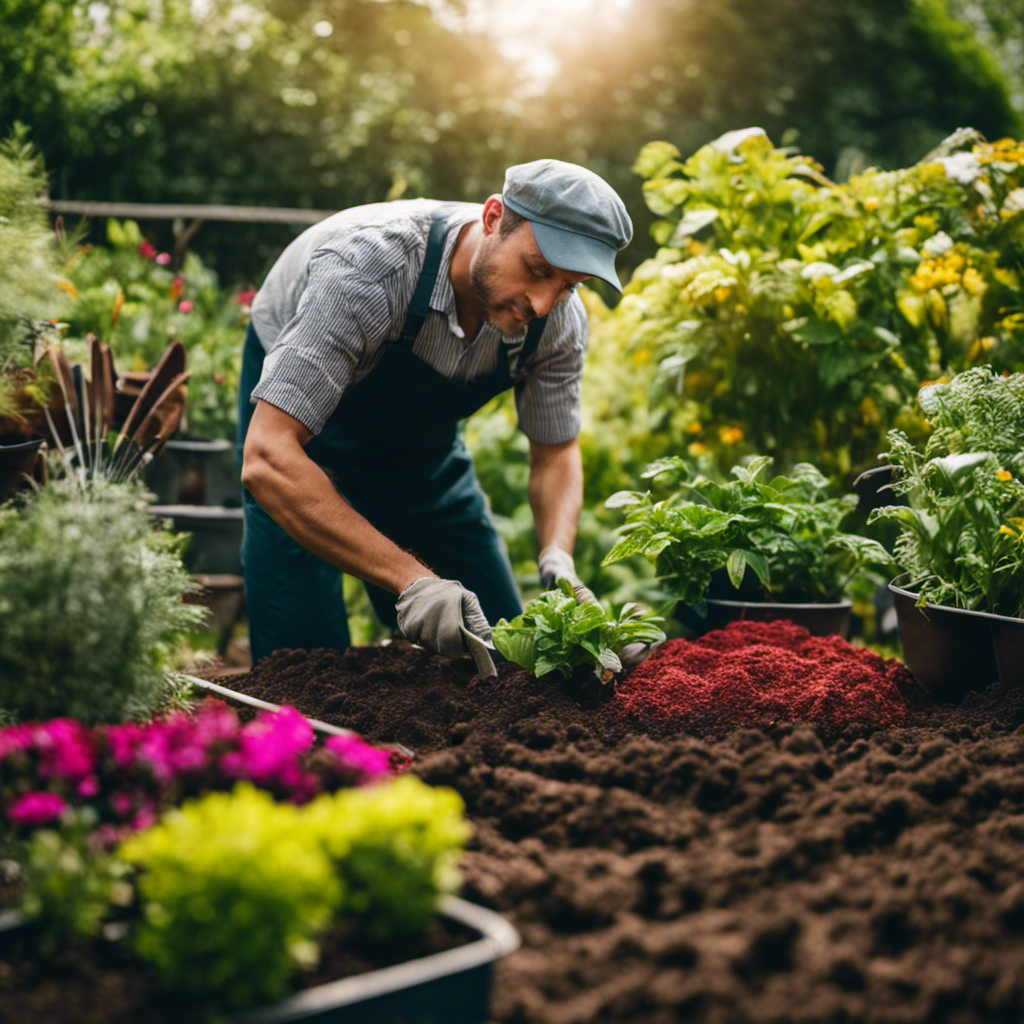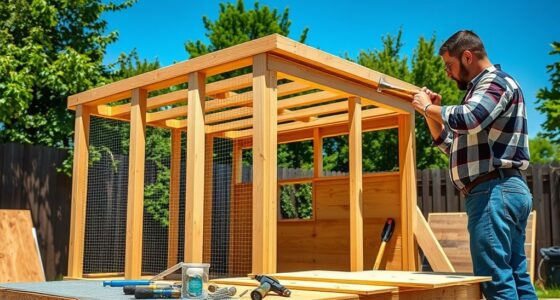We know what you’re thinking: maintaining a farmhouse property can be a daunting task. But fear not! With our ultimate guide, you’ll master the art of caretaking in no time.
From refreshing the exterior paint to inspecting for signs of damage, we’ve got you covered.
We’ll even share tips on garden maintenance, fixing broken fences, and efficient water management.
Get ready to enhance the beauty of your property and lower costs with our practical advice.
We need to make sure we stay on top of the regular upkeep of our farmhouse property to keep it in good condition. Regular upkeep is essential for maintaining the value and functionality of our property.
One important aspect of regular upkeep is budgeting for maintenance. By setting aside a specific amount of money each month for repairs and maintenance, we can avoid unexpected financial burdens.
Another crucial step is scheduling routine inspections. Regular inspections allow us to identify any potential issues before they become major problems. This proactive approach helps us save time, money, and stress in the long run.
Our farmhouse property’s exterior paint is starting to fade, so it’s time to refresh it and give our home a fresh new look.
When refreshing the exterior paint, there are a few things to consider.
Firstly, explore the various color options available to find one that complements the farmhouse’s style and surroundings. Earthy tones like beige or gray can create a rustic feel, while bolder colors like navy or red can make a statement.
Secondly, decide whether you want to tackle the project as a DIY or hire professionals. DIY painting can be cost-effective, but it requires proper preparation, equipment, and time. On the other hand, professionals have the expertise to deliver a flawless finish.
Lastly, remember to consider the weather conditions and plan accordingly to ensure the best results.
Let’s make sure to regularly inspect our farmhouse property for signs of damage and promptly address any issues that arise. Regular inspections are crucial in preventing costly repairs and maintaining the structural integrity of our property.
One key aspect to watch out for is preventing mold growth. Moisture is the main culprit behind mold, so it’s important to check for any water leaks or excessive humidity. Inspecting the roof, gutters, and downspouts for damage or blockages can help prevent water infiltration.
Additionally, identifying structural issues early on is essential. Look for cracks in the foundation, walls, or ceilings, as they could indicate underlying problems. Don’t forget to inspect the windows, doors, and insulation for any drafts or signs of wear.
When it comes to maintaining a beautiful landscape, efficient watering techniques and pest control strategies are key.
By implementing proper watering practices, such as deep watering and using mulch, you can ensure that your plants receive the right amount of moisture without wasting water.
Additionally, regularly inspecting for pests and using organic pest control methods can help keep your garden thriving and pest-free.
Let’s quickly address the issue of broken fences, as it’s crucial for ensuring the safety of our property. Maintaining sturdy and intact fences is vital not only for keeping our livestock secure but also for preventing unauthorized access to our farmhouse.
Here are three important points to consider:
Regular gutter cleaning is essential for maintaining a well-maintained property, as it helps prevent water damage and ensures proper drainage. Neglecting gutter maintenance can lead to a host of problems, including foundation damage, basement flooding, and even roof leaks.
To avoid these issues, it’s important to have your gutters cleaned at least twice a year, especially in areas with heavy rainfall or surrounded by trees.
In addition to regular cleaning, it’s also crucial to address any gutter repair needs promptly. Damaged or clogged gutters can impede proper water flow, causing overflowing and potential damage to your property.
If your gutters are beyond repair, gutter installation may be necessary to ensure optimal functionality and protection for your home. Remember, investing in gutter maintenance and repair now can save you from costly repairs down the line.
Pest infestation inspections are an essential part of farmhouse maintenance. By conducting regular inspections, we can detect any signs of pest activity early, preventing them from causing extensive damage to crops and the property.
In addition to professional inspections, there are also natural remedies available that can help control pests and protect the farmhouse from destruction.
Let’s get started with the essential tips for keeping our farm tools in top shape for long-lasting use. Here are three key practices to ensure the longevity of our equipment:
Our farmhouse’s chimney should be inspected and cleaned before winter to ensure the safety and efficiency of our heating system. Neglecting this crucial task can lead to chimney fires and poor indoor air quality.
To start, hire a professional chimney sweep who can thoroughly clean the chimney and check for any cracks or damage. They’ll also remove any debris or animal nests that may have accumulated. Additionally, consider installing a chimney cap to prevent animals from entering and to keep out rain and snow.
Another important step in winterizing our farmhouse is to insulate the attic and walls to prevent heat loss. This won’t only keep us warm but also save on heating costs.
Lastly, don’t forget to drain and insulate any outdoor water pipes to prevent them from freezing and bursting.
When it comes to barn maintenance, our main goal is to ensure a safe and functional space for our livestock and equipment.
We need to tackle roof repairs to prevent leaks and water damage, as well as conduct regular pest control measures to eliminate infestations that can harm our animals.
Additionally, it’s crucial to prioritize structural maintenance to ensure the stability of the barn and prevent any potential accidents or collapses.
The roof maintenance schedule is an important task for preserving the property and ensuring its longevity. Regular roof inspection and timely roof repairs are crucial to prevent potential damage and costly repairs down the line. To help you stay on top of your roof maintenance, here is a simple schedule to follow:
By conducting an annual roof inspection, you can identify any signs of damage, such as loose or missing shingles, leaks, or cracks. Biannual gutter cleaning will prevent clogs and ensure proper drainage, protecting your roof from water damage. Lastly, address any necessary roof repairs promptly to avoid further deterioration.
Efficient water management is another crucial aspect of maintaining a farmhouse property. Let’s explore some tips for effective water management to keep your property in top shape.
When it comes to efficient water management on a farmhouse property, there are several key tips that we should keep in mind.
First and foremost, implementing smart irrigation techniques for crops can significantly reduce water usage.
Additionally, exploring rainwater harvesting methods can help us make the most of natural water resources.
Lastly, we should strive to minimize water wastage by fixing leaks and using water-saving appliances.
Taking regular steps to maintain driveways and walkways is essential for ensuring safety and enhancing the overall aesthetics of our property.
Safety measures and maintenance tools play a crucial role in keeping these areas in top condition. To begin, it’s important to inspect the driveways and walkways regularly for any cracks, uneven surfaces, or debris.
Simple tools like a broom and a pressure washer can help remove dirt, leaves, and other debris, preventing slips and falls. Additionally, applying a sealant or protective coating can extend the lifespan of these surfaces, protecting them from weather damage and wear.
It’s also recommended to address any cracks or potholes promptly by using appropriate patching materials. By following these maintenance steps, we can ensure the safety of our driveways and walkways while enhancing the overall appearance of our property.
To maximize energy efficiency in our farmhouse, we can lower costs by using double-paned windows and properly insulating our walls and attic. These simple measures can make a significant impact on reducing our energy consumption and expenses.
Here are three key tips to help us achieve energy efficiency in our farmhouse:
Three ways to enhance the beauty of our property through landscaping maintenance are:
Key Takeaways
- Regular upkeep and maintenance of a farmhouse property is essential for maintaining its value and functionality.
- Scheduling routine inspections helps identify potential issues and avoid unexpected financial burdens.
- Proper exterior maintenance, including painting and fence repair, enhances the beauty and safety of the property.
- Implementing efficient watering techniques, pest control, and energy-saving measures contribute to a thriving and sustainable farmhouse property.
The Importance of Regular Upkeep
[bulkimporter_image id=’2′]
Refreshing the Exterior Paint: A Key Maintenance Task
[bulkimporter_image id=’3′]
Inspecting for Signs of Damage: A Must-Do Routine
[bulkimporter_image id=’4′]
Garden Maintenance: Tips for a Beautiful Landscape
[bulkimporter_image id=’5′]
Efficient Watering Techniques
The key to efficient watering techniques is to regularly monitor soil moisture levels and adjust watering schedules accordingly. This not only ensures that your plants receive the optimal amount of water, but also promotes water conservation. Here are three practical tips to help you master efficient watering:- Invest in irrigation systems: Installing drip irrigation or soaker hoses can significantly reduce water waste by delivering water directly to the roots of your plants. This method also prevents evaporation and runoff.
- Mulch, mulch, mulch: Adding a layer of organic mulch around your plants helps retain moisture in the soil, reducing the need for frequent watering. It also helps regulate soil temperature and suppresses weed growth.
- Water deeply and infrequently: Instead of shallow, frequent watering, give your plants a deep soak once or twice a week. This encourages deep root growth and makes plants more resilient to drought.
Pest Control Strategies
We can effectively manage pests in our garden by using a combination of natural repellents and regular monitoring. Natural pest control is a safe and environmentally friendly way to keep unwanted insects and animals at bay. One effective technique is companion planting, where certain plants are grown together to repel pests. For example, marigolds can deter aphids, while basil can keep mosquitoes away. Another technique is the use of homemade repellents. Essential oils like peppermint, garlic, and neem oil can be mixed with water and sprayed on plants to repel pests. Regular monitoring is essential to catch any pest infestations early on. By inspecting plants regularly and removing any signs of pests, we can prevent them from spreading and causing significant damage.Fixing Broken Fences: A Priority for Property Safety
[bulkimporter_image id=’6′]
- Regular inspection: Conduct routine checks to identify any damaged or weak sections of the fence. Look out for loose posts, broken wires, or sagging rails. Repair or replace these immediately to maintain the fence’s effectiveness.
- Invest in quality materials: When repairing or replacing fences, opt for durable materials that can withstand the elements and the wear and tear of farm life. This will ensure the longevity of your fence and minimize future maintenance needs.
- Reinforce against soil erosion: Along with repairing fences, take steps to prevent soil erosion around fence lines. Properly grading the land and installing erosion control measures, such as retaining walls or vegetation, can help protect the fence’s foundation and stability.
Gutter Cleaning: A Step Towards a Well-Maintained Property
[bulkimporter_image id=’7′]
Pest Infestation Inspections: Preventing Farmhouse Destruction
[bulkimporter_image id=’8′]
Early Detection Saves Crops
We need to be proactive in identifying potential crop threats to prevent extensive damage. Early warning signs play a crucial role in crop preservation. By detecting threats early on, we can take immediate action to mitigate their impact, ensuring the health and productivity of our crops. Here are three key strategies to help us master early detection:- Implement regular scouting: Regularly inspecting our fields allows us to identify any signs of pests, diseases, or nutrient deficiencies. By closely monitoring our crops, we can catch potential threats before they escalate.
- Utilize technology: Leveraging innovative tools like remote sensing and drones can provide us with real-time data on crop health. These technologies enable us to detect abnormalities and make informed decisions promptly.
- Foster strong relationships with experts: Collaborating with agricultural extension services, consultants, and other farmers can provide valuable insights and knowledge. These experts can help us identify potential threats and suggest effective preventive measures.
Natural Remedies for Pests
By incorporating organic solutions into our pest management practices, we can effectively combat infestations and safeguard our farmhouse from destruction. It is essential to prioritize natural remedies for pests and opt for organic pest control methods that are safe for both our crops and the environment. These natural remedies not only provide effective pest control but also ensure the long-term health and sustainability of our farmhouse property. Here is a table outlining some common natural remedies for pests:| Pest | Natural Remedy |
|---|---|
| Aphids | Neem oil spray |
| Slugs | Beer traps |
| Mosquitoes | Citronella candles |
| Mice | Peppermint oil spray |
| Ants | Borax and sugar bait |
Keeping Farm Tools in Top Shape: Tips for Longevity
[bulkimporter_image id=’9′]
- Regular Cleaning: After each use, make sure to clean our tools thoroughly. Remove any dirt, debris, or rust that may have accumulated. This will prevent any corrosion or damage that can occur over time.
- Proper Storage: Storing our tools correctly is crucial in maintaining their condition. Keep them in a dry and well-ventilated area, away from moisture and direct sunlight. Consider using hooks, racks, or toolboxes to organize and protect them.
- Timely Repairs: When our equipment requires repair, it’s essential to address the issue promptly. Regularly inspect our tools for any signs of wear and tear. Fixing small problems early on can prevent further damage and increase the lifespan of our tools.
Winterizing Your Farmhouse: Essential Steps to Protect Your Property
[bulkimporter_image id=’10’]
Barn Maintenance: Ensuring a Safe and Functional Space
[bulkimporter_image id=’11’]
Roof Repairs: Preventing Leaks
We should inspect our farmhouse roof at least once a year to identify and fix any potential leaks. Regular roof inspection and maintenance are crucial to ensure the longevity and durability of our farmhouse. Here are some key reasons why we should prioritize roof inspections:- Preventing Water Damage: Regular inspections allow us to catch any leaks early on, preventing costly water damage to our property.
- Maintaining Structural Integrity: By identifying and fixing any weak spots or damage, we can ensure that our roof maintains its structural integrity and protects our farmhouse.
- Extending Lifespan: Timely maintenance helps extend the lifespan of our roof, saving us from the hassle and expense of premature replacement.
Pest Control: Eliminating Infestations
After implementing effective pest control measures, such as regular inspections and proper sanitation practices, we can ensure a safe and functional barn space free from infestations. When it comes to pest control, there are two main approaches: natural pest control and professional extermination. Natural pest control methods involve using organic, non-toxic solutions to repel or eliminate pests. This can include using plants such as lavender or mint to deter insects, or introducing predator insects like ladybugs to control populations. On the other hand, professional extermination services can be highly effective for severe infestations or specific pests that require specialized treatment. It’s important to carefully consider the type of pest and the extent of the infestation before choosing the appropriate method.Structural Maintenance: Ensuring Stability
To maintain the stability of our barn, we regularly perform inspections and conduct necessary repairs. This ensures that our foundation remains strong and our structures are reinforced. Here are three important steps we take to maintain the stability of our barn:- Regular Inspections: We inspect our barn’s foundation and structures on a regular basis to identify any signs of damage or weaknesses. This allows us to catch any issues early on and prevent further damage.
- Repairing Foundations: If we notice any cracks or shifting in the foundation, we immediately address the problem by repairing and reinforcing it. This helps to maintain the overall stability of the barn and prevents costly structural damage.
- Reinforcing Structures: We reinforce our barn’s structures, such as beams and walls, to ensure they can withstand the test of time. This may involve adding additional support or replacing weakened materials.
Roof Maintenance Schedule: A Vital Task for Property Preservation
[bulkimporter_image id=’12’]
| Task | Frequency |
|---|---|
| Roof Inspection | Annually |
| Gutter Cleaning | Biannually |
| Roof Repairs | As needed |
Efficient Water Management: Tips for Farmhouse Owners
[bulkimporter_image id=’13’]
Irrigation Techniques for Crops
Our farmhouse property requires efficient irrigation techniques to ensure our crops receive the necessary water for optimal growth. Implementing proper irrigation methods not only helps conserve water but also plays a crucial role in crop yield optimization. Here are three essential techniques to consider:- Drip Irrigation: This method delivers water directly to the roots of the plants, minimizing water wastage and reducing the risk of evaporation. By providing a slow and steady water supply, drip irrigation promotes healthy root development and prevents water stress.
- Mulching: Applying a layer of organic mulch around the base of plants helps retain moisture in the soil. Mulch acts as a protective barrier, preventing evaporation and weed growth while maintaining a consistent soil temperature.
- Soil Moisture Sensors: These devices monitor the moisture levels in the soil, allowing farmers to determine when and how much water to apply. By providing real-time data, soil moisture sensors help optimize irrigation schedules and prevent overwatering or underwatering.
Rainwater Harvesting Methods
Let’s explore different rainwater harvesting methods to enhance our water management strategies on the farmhouse property. Rainwater harvesting offers numerous benefits, including reducing water bills, conserving groundwater, and promoting self-sustainability. To implement rainwater collection systems effectively, we need to consider a few key factors. First, it’s essential to assess the rainfall patterns in our area. This will help determine the size of the storage tanks needed to collect an adequate amount of water. Additionally, we should evaluate the available space on the property to install the collection system. Options range from simple rain barrels to more complex systems like underground cisterns or above-ground tanks connected to gutters. Next, we need to ensure proper filtration and purification methods to make the harvested rainwater safe for various uses. Installing filters and using UV sterilization or chemical treatments can help remove impurities and pathogens. Lastly, it’s crucial to regularly maintain the rainwater collection system. This includes cleaning the gutters, checking for leaks or blockages, and ensuring the storage tanks are in good condition.Minimizing Water Wastage
We can conserve water by implementing efficient irrigation techniques and repairing any leaks in the farmhouse’s plumbing system. To minimize water wastage, here are three practical tips:- Install a smart irrigation system: These systems use weather data to determine when and how much water your plants need, ensuring efficient water usage.
- Mulch your garden beds: Applying a layer of mulch helps retain moisture in the soil, reducing the need for frequent watering.
- Use drip irrigation: Drip irrigation delivers water directly to the roots of plants, minimizing evaporation and ensuring water goes where it’s needed most.
Maintaining Driveways and Walkways: Safety and Aesthetics
[bulkimporter_image id=’14’]
Energy Efficiency in a Farmhouse: Tips for Lowering Costs
[bulkimporter_image id=’15’]
- Incorporate renewable energy sources: Consider installing solar panels on the roof to harness the power of the sun and generate clean, renewable energy for our farmhouse. This not only reduces our reliance on traditional energy sources but also helps to lower our electricity bills.
- Invest in energy-efficient appliances: Upgrade our outdated appliances with energy-efficient models that have the ENERGY STAR certification. These appliances consume less energy while still providing the same level of performance, allowing us to save money on our electricity bills in the long run.
- Install programmable thermostats: Take advantage of technology by installing programmable thermostats in our farmhouse. These devices allow us to set different temperatures for different times of the day, ensuring that we’re only using energy when it’s necessary.
Landscaping Maintenance: Enhancing the Beauty of Your Property
[bulkimporter_image id=’16’]
- Regularly mowing the lawn
- Pruning the trees
- Planting colorful flowers
- Using native plants
- Implementing water-saving irrigation systems
- Practicing organic pest control
Frequently Asked Questions
How Often Should I Repaint the Exterior of My Farmhouse?
We find that repainting the exterior of our farmhouse every 5-7 years keeps it looking fresh and protects against weather damage. Opting for cost-effective paint options and proper maintenance can help extend the lifespan of the paint job.What Are the Signs of Damage That I Should Look Out for During Routine Inspections?
During routine inspections, we should look out for common signs of structural damage in a farmhouse, such as cracks in the foundation, sagging floors or ceilings, water damage, and wood rot. Proper maintenance of the foundation is crucial.How Can I Prevent Pests From Infesting My Farmhouse?
To prevent pests from infesting our farmhouse, we implement various preventive measures and use natural remedies. Regularly inspecting and sealing entry points, keeping the property clean and tidy, and using organic pest control methods are some effective strategies we employ.What Are Some Essential Steps to Winterize My Farmhouse and Protect It From the Elements?
Winterizing our farmhouse is crucial for protecting it from the elements. Our winterizing checklist includes sealing windows and doors, insulating pipes, clearing gutters, and servicing the heating system. These tips for weatherproofing ensure our property stays in top shape.How Can I Improve Energy Efficiency in My Farmhouse to Lower Costs?
To improve energy efficiency in our farmhouse, we can invest in energy-saving appliances and upgrade our insulation. For example, switching to LED light bulbs and insulating our attic can significantly lower our energy costs.What Are the Essential Maintenance Tips for Farmhouse Decor?
Explore this handy guide for maintaining your farmhouse decor’s charm. It’s crucial to frequently remove dust using a soft item, such as a microfiber cloth or feather duster, to prevent buildup. Avoid harsh cleaning agents that might compromise its welcoming aesthetic. For items made of wood, wiping them down with a moist cloth followed by a touch of furniture polish will maintain their luster. Puff up your cushions regularly to keep them looking and feeling plush. Proper maintenance of your farmhouse decor will ensure you continue to enjoy its delightful ambiance for a great deal of time.











